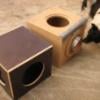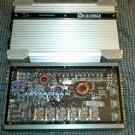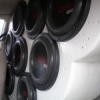Leaderboard
Popular Content
Showing content with the highest reputation on 12/07/2010 in all areas
-
1 pointCame home from today to see a package on my doorstep and I immediately became excited. SSA had sent me my Bravox CS60K's! Haven't gotten the chance to put them in yet but I will do a full review when I have. Also, these shipped very fast, especially for free shipping. It was shipped out next day after I ordered. Which is awesome because I hate waiting. These look very well made to me. Had to jump on these because of the price on them. Couldn't beat it. Thank You everyone as SSA. I am very pleased so far.
-
1 pointcrapshitfuck describes it well. Good luck sorting it out. We want pixorez quick ! ! ! I know they are shitty, but cell phone for now more better later when I am not driving illegally with a photocopied temporary tag. Where I like to go gets patrolled hourly.
-
1 pointNo worries, the day I stop learning is the day I die. Hope to help others continue as well.
-
1 pointIf you read the thread, that is nearly exactly what we are recommending. You got a little lost in the details though. -no real midbass will play to 2500Hz, my favorite bang for the buck driver has a hard time hitting 300Hz which means you are compromising a bit in the driver. Nonetheless there are choices. -For systems with output as the goal, having the subs play higher is no big deal and beneficial as they are more efficient by default than anything else you can use based on cone area -ANY decent horn can play WAY below 2300Hz, some down under 1kHz even -Overlapping can be a terrible idea much more often than a good one. And no it will do the opposite from being "warmer or smoother" -RTA's really shouldn't be used EXCEPT for to find anomalies, definitely not for setting up your system. You should set it up for yourself and not for some computer -EQ in general should not be to satisfy your "wants" but to remove the anomalies. Your "wants" should be solved in your installation. -Flat sounds like ass, always -You should generically speaking never use an eq to "move up from there" but to pull things down. EQ's are for making cuts, not boost. -I would say several weeks, not hours or days. The recommendation of using a midbass or better yet a dynamically capable midrange and a horn is the ONLY solution for getting loud, maintaining a stage, and still sounding good. Multiple drivers playing high frequencies is always a bad idea and a hell of a compromise in the wrong direction. quoted You know I said the truck would stage... but I NEVER said WELL ... wtf bro ?? I would NEVER put that system in competition. So far I've read is adding horns under the dash ... nothing about driver positioning ... how is this going to help your stage ?? What do you mean by stage but not very well, that makes absolutely no sense...unless you have a seriously jacked definition of stage. The horns will help significantly for a multitude of reason. A L/R point source will ALWAYS be easier to make cohesive than multiple point sources, the horns even under the dash will be as high if not higher than the tweets in the current door, and they can actually be aimed. Basically nearly every aspect of staging will be improved over what he has currently. again, best of luck with your system bro ... Thanks, Randal .......... And again, your suggestion won't have the dynamic capability that the OP wants. One normal tweet on each side will NOT "keep up" with his subs at all. Rudimentary understanding of sensitivity and power ratings will tell you that. He will definitely still need processing AND your off axis recommendation is not good either. We already went over this though. It won't.
-
1 pointKeep in mind that human's have rather poor hearing in grand scheme of things, with fairly poor auditory memory. Chances are good you could have walked someone into the room two days in a row, and they would have perceived slight differences in sound even if no changes were made at all to the system. Even more likely if innocent but subtle hints are inadvertently given. On top of that, we are subject to expectations (placebo effect....if we know something changed we'll expect a difference, and we'll then hear a difference), group think (if one person notices a supposed difference, the others will then "notice" it as well), and the power of persuasion (if you ask something innocent like "Notice anything different?", they'll expect there to be a difference and hence will "hear" one). I'm not saying no differences existed....there very well might have been a measurable and audible difference.....especially if listening position or speaker placement and aiming changed (that's a biggie!). But don't discount the power of psychoacoustics. Sugar pills cure illness every day around the world. Something to think about.
-
1 pointhttp://www.youtube.com/watch?v=qyQb192-CPQ Don't know why but I get a kick out of this commercial.
-
1 pointThere's not enough information to accurately answer your questions. I can throw out a few possibilities, whether or not any of these are the actual cause I can not guaranty as again.....not enough information,and I am by far and away anything but an expert on acoustics to begin with. What we would really need to directly and accurately answer your question would be.....wait for it.....objective measurements (!) of the system both before and after. But since those aren't available....... First, we'll just air this one out right now.......psychoacoustics. And the typical response to this statement is "I know what I heard, the difference was there! Don't tell me I didn't hear it!" Well, really, without some type of measurement, you can't prove there was any difference. Again, the problem of subjective statements rears it's ugly head. My car system will sound slightly different on different days depending on my mood, what nuances I (subconsciously or consciously) focus on that day, etc. If you tell me your system sounds exactly the same every single day, I'd call you a liar. But, now that we have that out of the way, we can move on to some physical reasons of why you may have heard a change. I can not and will not argue the point of measuring the response of the drivers as it was not done. In hindsight, I should have pulled out my iPhone, turned on the rta and played some pink noise both before and after to see if there was any change, but I didn't so I guess that's a big FAIL for me. We were just comparing the different cabinets with the 5.25, the 6 and the 8 inch components by listening to musical selections we were very familiar with and thought that the midrange was a little less detailed on the 6 and 8 inch components and thought a change needed to be made. A change in either listening position or location of the speakers within the listening space will affect the frequency response, and hence can cause an audible change. You might think think the change was minor or unobservable in the space, but audio is a game where inches can make a difference in response shape as it will change the interference pattern of the speakers and their interaction with the room, among other things. This is something I had not considered. I cannot say that the speakers were placed in exactly the same spot because we moved them from one room, out to the install bay, and back into the room. Placement may or may not have been in exactly the same spot as before. That being said, I do know that minor changes in angle on tweeters as observed in my own vehicle made a world of difference in imaging so I assume it could do the same for frequency response. Adding/moving/relocating damping material within the enclosure would affect standing waves and reflections within the enclosure, which could be observed in frequency response. There was no damping material in the enclosure at the time so that would not have been it, but something I should have mentioned. Sorry to have left that out. I don't know how you accessed the port, but removing a panel/port/driver and resealing it might have caused a change in an air leak which was affecting a particular band of midrange frequencies. The port was external to the box so a cap could be placed over the port to convert it to a sealed enclosure and we simply cut off about an inch of the external portion of the port. Driver did not come out of the box, nor did the port, but great care was taken to ensure the enclosure was well sealed from air leaks. If you removed any speaker wire leads, you may have reconnected them in a different polarity (maybe they were incorrectly phased previously, and after reconnection were properly wired in relative phase). Wiring was put back in the same polarity as before, and something we had considered so we checked to make sure it was the same. There might have been a relative change in frequency response due to the change in tuning which made the midrange seem more pronounced even though it's actual frequency response was unaffected (although the response of the system as a whole changed). This is the kind of thing I want to learn more about. Is there a "layman's terms" way to explain this? From everything I've learned, the port will allow some midrange energy to escape though it. How much and how pronounced depends on a whole host of factors.....but this is supposedly one of the reasons why many home speakers have the port facing rearward, so that midrange energy that escapes interferes less with the direct wave radiating from the speaker. I suppose it might be possible that the tuning frequency and location of the port end in the enclosure or of the bandwidth of midrange frequencies affected/escaping might cause a noticeable difference in midrange depending on the host of factors which affect it (enclosure design, port location, damping material within the enclosure, etc etc). The port on these enclosures is on the back as well. Did not know that midrange frequencies would escape through a port, but that makes sense. A change in the tuning frequency would change the alignment of the speaker and it's excursion levels at various frequencies, which may have caused a slight change in how the driver behaved in the midrange frequencies (such as slightly affecting intermodulation distortion, etc). The tuning frequency only changed 2-4hz which is what confused me. I didn't think a change that small in tuning would affect anything that much higher up in the frequency range. My list is not comprehensive, and I can not promise that any single one of those are a contributing factor. It might be none of the above, or a combination of several. Some of them are kinda stretching the realm of audibility, threw them out there as options mainly to just list everything that popped into my head as I sat here typing. And that was just a list off the top of my head, some research into the issue and far more details about the setup may reveal many more possibilities I can't think of off hand or am unaware of. It may not be comprehensive, but it went a looooong way to helping me understand a bit more about how sound works. As always, you have explained something that confused the heck out of me in a way that I can understand. Thank you. But we'll never really know....since there aren't any objective measurements of the before and after to demonstrate what did or didn't change. What still confuses me is that this change was observed (rightly or wrongly) by multiple people's ears in different locations (buildings) and environments AND on different days, not just one. Also, to make it even more confusing to me, some of these people did not know that a change had been made to the enclosure, but a difference was heard by them as well. That's the part I'm having difficulty with in regards to the measurements thing. If I make a change in something, I know it was made and therefore will THINK I hear a difference. That part I agree with wholeheartedly. But when people listen multiple times a day to the same setup and then a change is made without telling them and they hear a difference, THAT's what I don't understand. Maybe it's psychoacoustics, but what if it isn't? Thanks again!
-
1 pointNicely put. I would stress the fact that if these weren't truly A/B tested BLINDLY then I'd really chock it up to pyschoacoustics. One other thing Brad left out that pops up in my mind. It is possible for the particular track that the low frequency information was stressing the driver with the low tuning causing other anomalies higher up in the response. Once the tuning was raised this could have gone away. Acoustic masking is a bitch as well, plenty of different ways that could rear its head and have you notice/not notice things with very minor changes.
-
1 pointThere's not enough information to accurately answer your questions. I can throw out a few possibilities, whether or not any of these are the actual cause I can not guaranty as again.....not enough information,and I am by far and away anything but an expert on acoustics to begin with. What we would really need to directly and accurately answer your question would be.....wait for it.....objective measurements (!) of the system both before and after. But since those aren't available....... First, we'll just air this one out right now.......psychoacoustics. And the typical response to this statement is "I know what I heard, the difference was there! Don't tell me I didn't hear it!" Well, really, without some type of measurement, you can't prove there was any difference. Again, the problem of subjective statements rears it's ugly head. My car system will sound slightly different on different days depending on my mood, what nuances I (subconsciously or consciously) focus on that day, etc. If you tell me your system sounds exactly the same every single day, I'd call you a liar. But, now that we have that out of the way, we can move on to some physical reasons of why you may have heard a change. A change in either listening position or location of the speakers within the listening space will affect the frequency response, and hence can cause an audible change. You might think think the change was minor or unobservable in the space, but audio is a game where inches can make a difference in response shape as it will change the interference pattern of the speakers and their interaction with the room, among other things. Adding/moving/relocating damping material within the enclosure would affect standing waves and reflections within the enclosure, which could be observed in frequency response. I don't know how you accessed the port, but removing a panel/port/driver and resealing it might have caused a change in an air leak which was affecting a particular band of midrange frequencies. If you removed any speaker wire leads, you may have reconnected them in a different polarity (maybe they were incorrectly phased previously, and after reconnection were properly wired in relative phase). There might have been a relative change in frequency response due to the change in tuning which made the midrange seem more pronounced even though it's actual frequency response was unaffected (although the response of the system as a whole changed). From everything I've learned, the port will allow some midrange energy to escape though it. How much and how pronounced depends on a whole host of factors.....but this is supposedly one of the reasons why many home speakers have the port facing rearward, so that midrange energy that escapes interferes less with the direct wave radiating from the speaker. I suppose it might be possible that the tuning frequency and location of the port end in the enclosure or of the bandwidth of midrange frequencies affected/escaping might cause a noticeable difference in midrange depending on the host of factors which affect it (enclosure design, port location, damping material within the enclosure, etc etc). A change in the tuning frequency would change the alignment of the speaker and it's excursion levels at various frequencies, which may have caused a slight change in how the driver behaved in the midrange frequencies (such as slightly affecting intermodulation distortion, etc). My list is not comprehensive, and I can not promise that any single one of those are a contributing factor. It might be none of the above, or a combination of several. Some of them are kinda stretching the realm of audibility, threw them out there as options mainly to just list everything that popped into my head as I sat here typing. And that was just a list off the top of my head, some research into the issue and far more details about the setup may reveal many more possibilities I can't think of off hand or am unaware of. But we'll never really know....since there aren't any objective measurements of the before and after to demonstrate what did or didn't change.
-
1 point
-
1 pointThe ones on ebay are like the wholesalers...they may not be authorized or something but its still a genuine product...probably won't have warranty either.
-
1 pointWhat if I only have 0.5cf of space ? I spend my money to buy the speaker and realize it doesn't sound good in that space. What now ? Take an angle grinder and modify my car to fit the speaker ? Or sell a speaker which was used 15 minutes and lose money ? Considering most software which respects itself uses formulas from Vance Dickinson's book, stating that programs are written bad is like stating that the book is written bad and that poor fella has no clue. A bit of reasoning and common sense please
-
1 pointStop taking things emotionally and personally and read objectively it will really help this conversation No one has ever ridiculed or insulted any of you other than your silly approach of saying it sounds the best to me so therefore these are the greatest speakers since sliced bread. Instead please respond for ONCE without any subjective nonsense which in your whole post you again forgot to do Um, you can't analyze one spec but only the set. As for showing what they do "free-air" they will actually show what they will do in any environment as long as that environment is known. I've offered and asked now three times for someone to show where this isn't the case but no one in the subjective camp has anything to say about that. Considering this is the case, there is another SIMPLE question you could answer. Ask Ray how he designed specifically for "dynamics, realism, and that "I was there live" feeling one gets when listening to a musical passage" when he designed the drivers. This would be some scientific input we would all really love to hear. Perfect, please share how this design was developed and what was done to make this happen. That would be stellar. As for the second portion of the quote, no one on here would ever recommend 24 speakers and that bs which is rather obvious from tons of other threads on the forum. Stop, again NO ONE on here cares what you think about how your car sounds. This isn't a knock on your hearing, but the fact that the subjective nature of that response is nonsense. There are tons of us that could easily say the same about our vehicles but you don't see that happening now do you? The only ones in the pissing contest seem to be in your camp, we are not competing with that as we surely don't believe in it. There is really only one way to be helpful and you haven't. Answer Impious or my questions. If you don't know how or can't ask for clarification. Since you seem rather convinced these were designed to be musical and ... then share the design process of how that was done. The only reason you could be taking any of this as insulting is if you are reacting emotionally to the fact that your subjective opinion matters not. Silly thing to get insulted over. As for understanding specifications, we'd be glad to help but there seems to be a disconnect in your understanding completely. As a whole they will describe EXACTLY what a driver will do in ANY environment so you can imagine the complexity of your answer. As a primer, pick up a copy of Vance Dickason's book, Loudspeaker Design Cookbook and read it. Once you absorb that it will make answering your question VERY easy Again, there is only one way to make this thread something we can learn from and it is for your camp to share something objective. IE, not subjective, not emotional and not about what YOU have heard. Instead share Ray's design process, his testing process, how he has tweaked standard driver design to do what he has done. So far we have no details AT ALL on the driver other than what we can see from the pictures and pricing and on the surface the two do not make sense together. Let me give you one other bit of insight. Basically everyone who reads this thread is getting a really bad picture of Blues, and not at all from Impious or my responses but from yours. I am sure that without answering our very simple questions you guys are doing a really good job of destroying potential customers instead of helping yourselves. This is the internet, people don't buy on emotion that they aren't connected to and that is ALL that you guys are sharing. For the sake of this forum, your company, and rudimentary science please stop. I'd love to see you guys post something useful and challenge you to try as so far it has just been one heck of a mess. Please prove me wrong. And again, don't take this personally. I have nothing against any of you and actually at this point am just amused at the stubbornness, but I do look forward to a real response.
-
0 pointsQuoted The only reason people think there is a need for 3000000000 mids in a door is either 1. To show off their fiberglassing skills 2. or their forum dicks will look bigger.
-
0 pointsI wasn't mentioning any names but ... I've never seen steve's truck, so I'm going by what I was told. Johnathon's truck will stage (I know who built it), he just doesn't know anything about the setup good enough to tune it, And take care of it ... Besides, this is what you said you were looking for ... Has that changed ?? Duran, I was only given suggestions bro ... I would never set my ride up that way, you know this ...
-
-1 pointsYou could try to find the popular silver tahoe thats all over youtube ... That mids and highs setup can keep up with 4 18s just fine ... hint - (smd) ... You could try to find the popular blue tahoe thats all over youtube ... That mids and highs setup can keep up with 4 18s just fine ... hint - (d4s) ... I do know of a black 2500 silverado with a snug top running 16 10s (150db all day long on music) using a pair of tweeters in the As and a pair of 8s in the kicks. This setup should be able to keep up with 4 18s just fine ... No horns on any of these vehicles ... and if I remember correctly, they all stage fairly decent too ... especially the 2500 silverado ... thanks ...
-
-1 pointsYou know I said the truck would stage... but I NEVER said WELL ... wtf bro ?? I would NEVER put that system in competition. 1 door out of the whole system ?? I thought you were interested in the A-pillars ... I was the first one in this thread to give my oppinion and THIS was not it ... you know that. I thought we had an understanding ?? So far I've read is adding horns under the dash ... nothing about driver positioning ... how is this going to help your stage ?? I apologise for trying to help ... best of luck to ya bro on your system ... THIS was my suggestion ... several post back at the start of this thread ... again, best of luck with your system bro ... Thanks, Randal ..........





